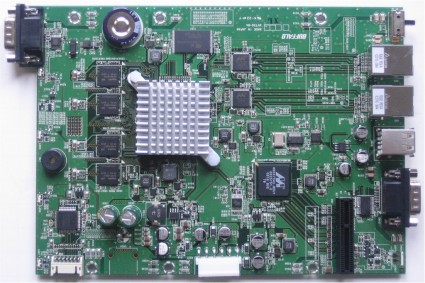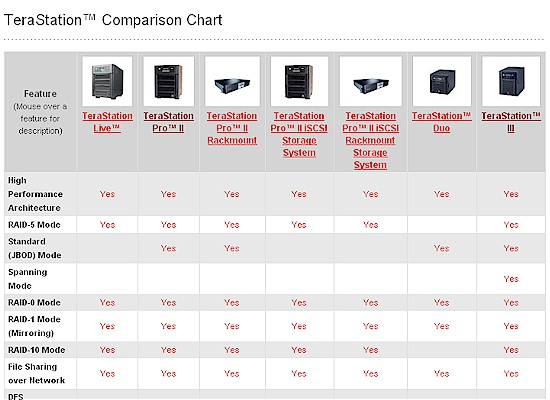Introduction
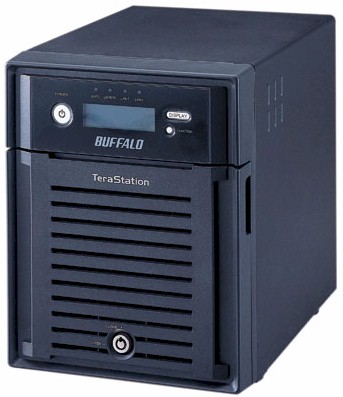
| At a Glance | |
|---|---|
| Product | Buffalo TeraStation III (TS-X2.0TL/R5) |
| Summary | Updated, faster version of Buffalo’s top-of-the-line quad-drive small-business NAS |
| Pros | • 50 MB/s RAID 5 reads • NFS and DFS support • Dual Gigabit Ethernet with failover, aggregation |
| Cons | • Slow USB backup • No logging; miserly status • No eSATA port |
Buffalo’s LinkStation Pro XHL restored my faith in Buffalo’s ability to build a high-performance, reasonably-priced single drive NAS. With the TeraStation III, it looks like Buffalo can apply the same price / performance improvement magic to a four-bay RAID 5/10 product.
The III bears a family resemblance to its TeraStation Live and Pro II predecessors. But it’s about four inches shorter, although it has the same footprint. Buffalo sent the 2 TB version for review. But you can also get a Tera III in a 4 TB configuration and a 6 TB version will follow soon.
Figure 1 shows the lockable front door swung open to reveal the four hot-swappable 3.5" SATA drives snug in their trays.
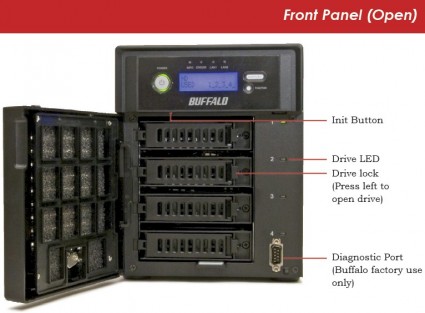
Figure 1: Tera III with door open
I’m sure it’s probably a security "feature", but I didn’t like that you could not leave the door unlocked and remove the key. You also can’t see the drive LEDs without opening the door, which is disappointing if you like to watch drive activity lights flashing away. Don’t get too excited about the Diagnostic Port behind the front door. The serial port appears to provide a Linux console output. But it didn’t respond to the keyboard input from the terminal emulator that I used to check it out.
The Power Mode switch caused a bit of confusion because it came set to Auto and I don’t use Buffalo’s NAS Navigator utility. It took a few unrequested shutdowns for me to remember to flip it to Manual, which kept it up and running until I shut it down by press-and-holding the front panel Power button.
Even if you don’t use the NAS Navigator, you can set three sleep / wake schedules for power management. The Function button up next to the LCD display initiates a RAID rebuild after hot-swapping a drive, dismounts USB drives and starts a copy from a USB drive. The Display button cycles you through the various status displays that include Link Status for both Gigabit Ethernet ports, Drive status, IP address, RAID status, Date / Time and Firmware revision. I found it handy that the display will stay on the selected screen until you change it.
The Tera III draws 45 W when active and 12 W when sleeping. You’ll hear the easily-replaceable fan when the NAS is booting, but it quiets down when boot time is over. Like the Pro XHL, the Tera III’s fan stayed quiet, even when I ran the heavy-use iozone tests. The bulk of the III’s noise is from the four drives, which ran very quietly and make the Tera III one of the quietest four-drive NASes that I have seen.
Internal Details
The slideshow has some good pictures of the III’s insides, which are easily accessed by removing five screws and sliding the metal cover off. Given the III’s target business audience, Buffalo has tried to make the power supply and fan—the highest failure rate parts after the drives—easily replaceable. The fan is mounted on a removable panel and has a standard mini power connector and the power supply sits right on top.
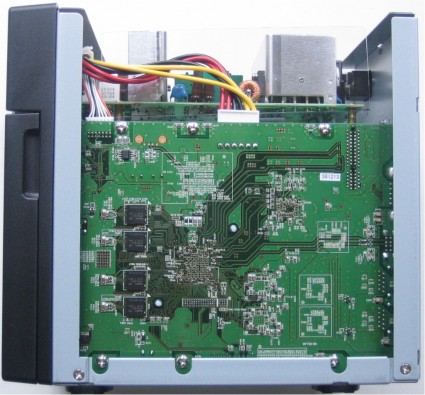
Figure 2: Inside right view
Getting the main board out so that I could take its picture required a bit more effort, including removing the rear panel. I also had to remove the heatsink (secured via an adhesive thermal pad) to find that the Tera III is the first NAS I have seen to use another new Marvell processor, an MV78100-A0 C080 Single-core ARMv5TE-compliant Feroceon clocked at 800 MHz.
Figure 3: TeraStation III main board
The processor is teamed with a Marvell 88SX7042 SATA II controller that handles the four 3.5" WD WD5000AAKS Caviar Blue 500 GB drives that came in the 2 TB version sent for review. Like other Buffalo NASes, the drives are XFS-formatted.
The memory complement includes 512 MB of soldered-on-board RAM as well as 512 MB of flash. Dual Marvell 88E1118s provide two Gigabit Ethernet ports that support independent, redundant, auto-failover and multiple aggregation modes and 4, 7 and 9 K jumbo frames. I also found an NEC UPD78F0513 8-bit single-chip microcontroller, which looks like it supports the front LCD panel and buttons.
Two USB 2.0 ports can be used to connect USB flash and hard drives for expansion or backup and USB printers for sharing. UPS synchronization is supported via a single serial port, which I thought is a step backward considering the USB interfaces used by many of today’s UPSes. I was also disappointed to find no eSATA port that could handle faster (than USB) attached drives for speedier backup.
Features
The TeraStation Comparison Chart summarizes the Tera III’s feature set, most of which (aside from RAID) is shared by the LinkStation Pro XHL. Consult the Pro XHL review and slideshow if you want more detail on the common features. The Tera III slideshow has screenshots and descriptions of its unique features.
Figure 4: TeraStation Comparison Chart (partial view)
The high level summary is that you can think of the Tera III as a four-drive RAID 0 / 1 / 5 / 10 version of the LinkStation Pro XHL that supports joining NT domains and Active Directories for user account information.
This means that the Tera III includes UPnP AV / DLNA and iTunes media serving as well as BitTorrent downloading—a bit odd for a product aimed at small businesses. But given that the competition has taken the approach of offering similar consumer features and more across their entire product lines, this is a move in the right direction for Buffalo.
Also shared with the Pro XHL are the Tera III’s backup features. So it can do immediate or scheduled back up to an attached USB drive or another networked LinkStation or TeraStation. Also like the XHL (and other Buffalo NASes) backups can be encrypted, compressed or both. The III can format USB drives in FAT32, EXT3 or its native XFS and supports read and write to all three. It will also mount an NTFS-formatted drive for sharing, but not write to it.
As with other Buffalo NASes, you get one license for Memeo Backup, which is rather stingy, given the multiple (and sometimes, unlimited) backup client licenses offered with other products.
The Tera III’s user interface is the new AJAX-based one used by the LinkStation Pro XHL, vs. the older style used in the TeraStation Pro II. Unfortunately, the III’s interface shares the shortcomings of the Pro XHL’s, i.e. no logging and meager status information. This time, however, I was able to get email alerts working, which is probably due to my enabling the III’s TLS option, even though my SMTP server supposedly doesn’t use it.
The III’s unique features (vs. the LinkStation Pro XHL) include:
- Support for eight Distributed File System (DFS) links for SAN-like storage expansion
- Port trunking options for the dual Gigabit Ethernet ports including independent, redundant, auto-failover and multiple aggregation modes
- NFS support
- JBOD, RAID 0, 1, 5 and 10 support with hot spare for RAID 1 and 5. Two arrays are supported, but with only four drives, options are limited. RAID 0 is supported only for four drives and only RAID 1 can be configured for two drive use. You can have a three-drive RAID 5 array, however.
- Drives and RAID arrrays can be optionally be 128 bit AES encrypted
- TeraSearch function that creates an index of files in selected folders to support a filename search function.
RAID Fail Test
I performed a pull-a-drive test on a three-drive RAID 5 array configured with a hot spare. After starting a large folder transfer to the Tera III, I pulled the #2 drive. Within 5 seconds of pulling the drive the LCD panel flashed red and the internal beeper sounded for around 10 seconds. When I checked my email about 30 seconds later, I had received 15 messages telling me about various drive and volume errors. I then logged into the NAS and was taken taken to a page that told me that a volume rebuild was in progress (Figure 5).
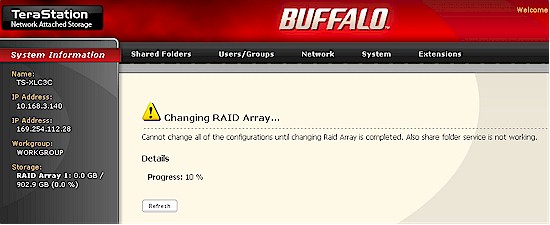
Figure 5: Login landing page after hot spare swap-in
I should note that the file copy was temporarily interrupted about 30 seconds after the drive was pulled. But when I checked to see if my data was still there, I found that it was and that I could again read and write files to the Tera III’s share.
The main negatives in the process were that I did not receive an email notice that the hot spare had been swapped in and the rebuild started. The LCD panel also doesn’t automatically switch to show that a rebuild has started, nor does it display % completion of the rebuild. I did get an email, however, when the rebuild finished, around four hours later.
After the rebuild completed, I then pulled the #4 drive on the new three-drive RAID 5 array, which now had no hot spare. Once again the LCD panel flashed red and the beeper sounded and multiple email error notices were sent. But this time when I logged into the Tera III, I landed at the normal Shared Folders page, with no indication that anything was amiss. I had to navigate to the System > Storage page and open the RAID Array section to find an Error status.
When there is no hot spare set up to swap in, you must inititate a RAID rebuild manually. So I reinserted the #2 drive (the one pulled in the initial test) and immediately saw the LCD panel turn red and display a Press FuncSW New disk2 ready message. My first button press had no effect, so I consulted the manual and found that I needed to press the Function button until I heard a beep to release it.
At this point you need to be patient, since the panel switches back to the default Link Speed screen (but remains red) and you won’t see any rebuild indication on the System > Storage > RAID Array page if you check it right away. But about three minutes later, while I was wondering what to do next, I heard the Tera III’s drives start to chatter.
When I then checked the RAID Array status, it showed that the rebuild had started. But the LCD screen took another minute to catch up and turn back to its normal blue color. Finally, I received three pair of emails saying that rebuild had started then completed, plus one additional rebuild start email. I then finally received a rebuild finished email about four hours later.
So the RAID rebuild process seems straightforward enough. But, as noted, you do need to be patient since it takes a few minutes for the LCD panel, web admin interface and email status to all get updated.
Performance – Backup
I put the Tera III running 1.00 version firmware through our new test process. Tests were run with 1000 Mbps and 1000 Mbps with 4k jumbo LAN connections. I ran some tests with 100 Mbps LAN connections, but not all, since it was obvious that the Tera III’s performance is limited by a 100 Mbps LAN connection. In the future, I will run tests with a 100 Mbps LAN connection only for products with sub 12.5 MB/s performance.
I first checked backup performance to an Iomega UltraMax Pro Desktop Hard Drive configured in RAID 0 attached to one of the III’s USB 2.0 ports. The test copies the 4.35 GB ripped DVD test folder that I use in the NAS Chart Vista SP1 file copy tests from the NAS to the attached drive. Since I also still had the Pro XHL, I was able to run a NAS-to-NAS backup test. The results are summarized in Table 1.
| Product | Backup Throughput (MBytes/s) |
|---|---|
| USB – FAT32 | 9.68 |
| USB – EXT3 | 8.30 |
| USB – XFS | 8.79 |
| NAS-NAS (Linkstation Pro XHL) |
16.85 |
Table 1: Backup throughput test summary
Clearly, the Tera III’s backup performance isn’t anything to write home about. The good news is that it’s about twice as fast as the 5 MB/s I measured for the Seagate BlackArmor for a FAT32-formatted USB backup. But it’s about 40% slower than the Synology DS508.
I don’t have anything to compare the almost 17 MB/s NAS-to-NAS backup speed against, since the Tera III is the first product that I have measured for NAS-to-NAS backup. But given that the Pro XHL backup target’s Gigabit-connected average write performance is just shy of 40 MB/s, it’s unlikely that it is the limiting factor.
Performance – Write / Read
Figure 6 presents a summary of the benchmark tests run for the Tera III, with only the 1000 Mbps LAN RAID 0, 5 and 10 results plotted. Although write cache effects are in play at smaller file sizes, you don’t see the extreme cached performance exhibited by other products.
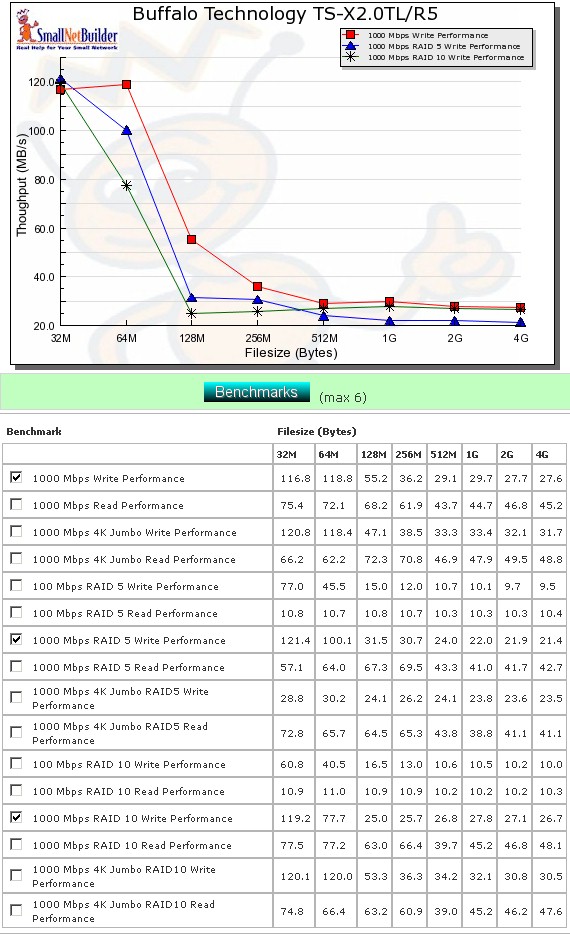
Figure 6: Write Performance Benchmark summary
Write performance with a 1000 Mbps LAN connection averaged over the 32 MB to 4 GB file sizes and with cached results above 125 MB/s removed from the average comes in at 55.1, 46.6 and 44.5 MB/s for RAID 0, 5 and 10 configurations, respectively.
Read speeds (Figure 7) for the same conditions averaged 57.3, 53.3 and 58.0 MB/s.
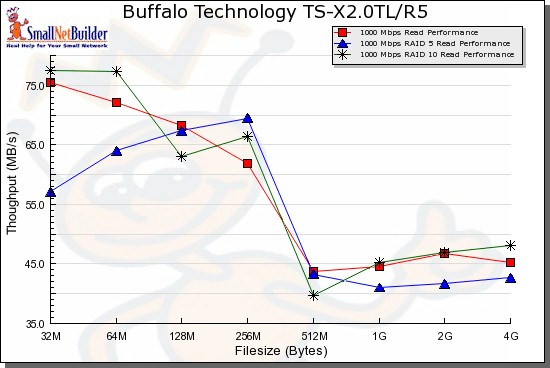
Figure 7: Read Performance Benchmark summary
As usual with our new test platform, 4K jumbo frames don’t provide any significant difference in performance.
The Tera III holds its own against other current-generation NASes in Vista SP1 filecopy testing, measuring 32.4 MB/s, 24.0 and 31.4 MB/s for RAID 0, 5 and 10 write and 59.5, 55.1 and 55.9 MB/s for read.
Performance – Competitive
For a competitive comparison, I chose the four top-performing RAID 5 NASes tested on the new test platform: the NETGEAR ReadyNAS Pro, Thecus N3200 Pro and Synology DS508. I also included the Terastation Pro II even though it was tested on the old test platform, to contrast the Tera III’s performance improvement.
Figure 8 shows the products’ RAID 5 write performance. Unfortunately, the ReadyNAS Pro’s unusually high cached performance compresses the plot and makes it hard to see the performance difference once you get out beyond caching at the 256 MB file size and higher. But if you look at the table below the plots, you see the ReadyNAS Pro coming in first with performance hovering around 40 MB/s, then the Synology around 30 MB/s and the Thecus and Tera III turning in about equal performance in the low 20 MB/s. The TeraStation Pro II is left in the dust with speeds in the low teens.
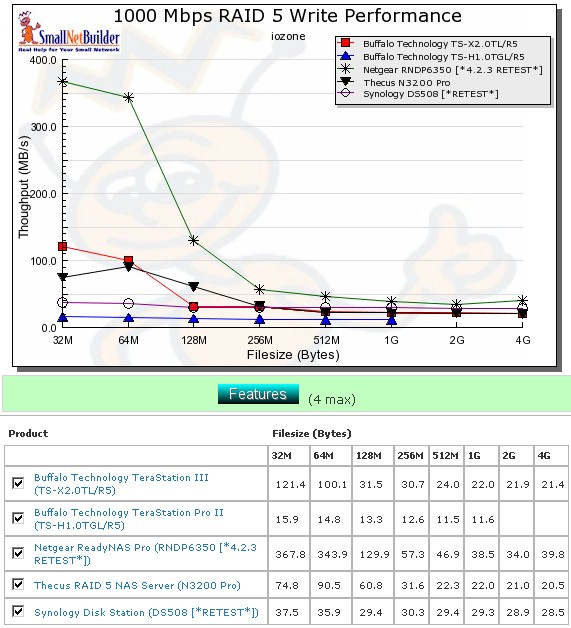
Figure 8: Competitive RAID 5 write comparison – 1000 Mbps LAN
Figure 9 compares the read performance, which is a bit harder to sort out visually, except for the TeraStation Pro II. You really have to look at the averaged values, which come in at 57.9, 53.3, 52.4 and 48.3 MB/s for the NETGEAR, Buffalo, Thecus and Synology, respectively.
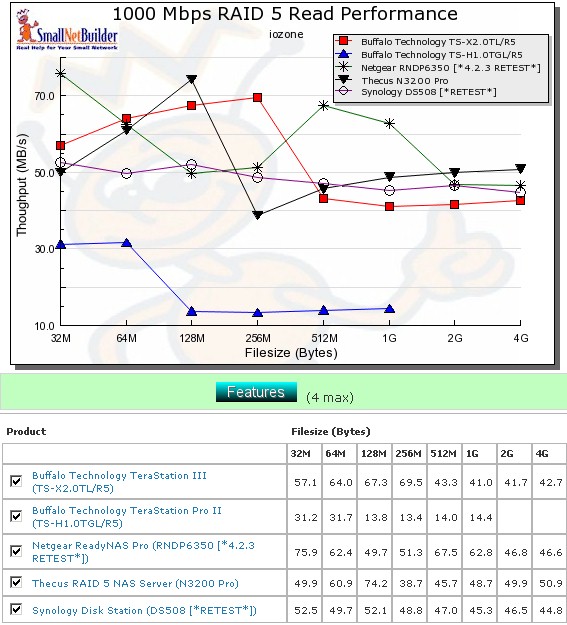
Figure 9: Competitive RAID 5 read comparison – 1000 Mbps LAN
Closing Thoughts
As with the LinkStation Pro XHL and single-drive NASes, the TeraStation III puts Buffalo back into serious competition in the highly-competitive four-drive RAID 5 NAS field. With average RAID 5 and 10 read speeds in the 50 MB/s neighborhood, 2 TB of storage and a current price as low as $875 (although typical prices are closer to $1000), the TeraStation III is a pretty attractive choice for buyers looking for a high-performance business-focused NAS without "server" features that they don’t need. And the 3 year warranty sweetens the deal even more.
![]() See the slideshow for an admin interface walkthrough and internal photos
See the slideshow for an admin interface walkthrough and internal photos

